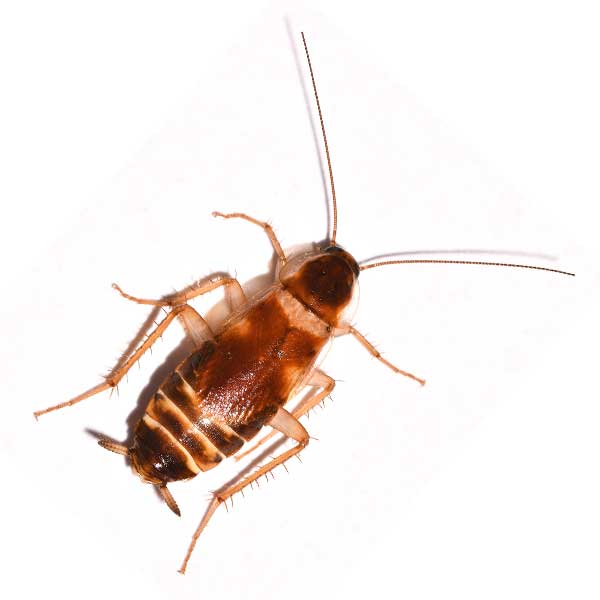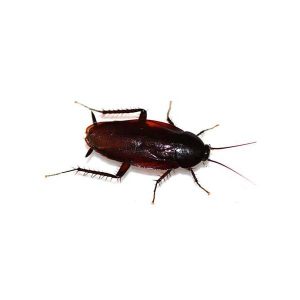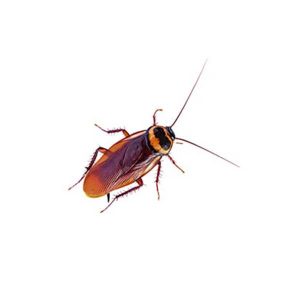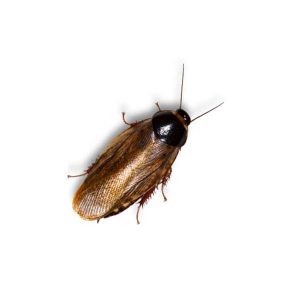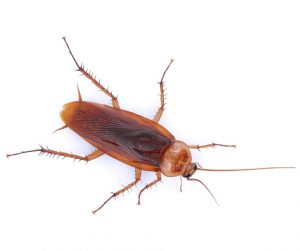Brown-Banded Cockroaches in Georgia
Brown-banded cockroaches (Supella longipalpa) are among the most common and resilient cockroach species in homes across Georgia. These pests are particularly adaptable, thriving in the state’s warm climate and often inhabiting drier areas of your home, unlike the German cockroach (Blattella germanica), which prefers humid environments.
Brown-Banded Cockroach Facts and Identification
What Do Brown-Banded Cockroaches Look Like?
Brown-banded cockroaches (Supella longipalpa) are among the most common and resilient cockroach species in homes across Georgia. These pests are particularly adaptable, thriving in the state’s warm climate and often inhabiting drier areas of your home, unlike the German cockroach (Blattella germanica), which prefers humid environments. Brown-banded roaches are light to medium brown in color with darker bell shapes on the area directly behind their head (pronotum). They also have brown stripes across their bodies as juveniles, and across their wings as adults. Despite their small size, maxing out around 1.1 to 1.5 cm, brown-banded cockroaches are notorious for their varied diet. Unlike many other cockroach species that seek out water sources, brown-banded cockroaches tend to avoid them.
Signs of a Brown-Banded Cockroach Infestation
Brown-banded cockroaches prefer warm, dry, and elevated locations, making them likely to infest areas like kitchens, closets, and behind wallpaper. Unlike German cockroaches, which are often found near sources of moisture, brown-banded cockroaches are more likely to be found in less obvious places. Common signs of an infestation include:
- Droppings: Small, dark specks or smears, often found in corners, on top of cabinets, or inside electrical appliances.
- Egg Capsules (Oothecae): Brown-banded cockroach females produce reddish-brown egg cases known as oothecae, which contain multiple eggs. These cases are often glued to surfaces like furniture, walls, or ceilings.
- Shed Skins: As nymphs grow, they shed their skins, often found in hidden crevices or near their nesting sites.
- Unpleasant Odor: A strong, musty odor is often associated with a significant infestation.
Recognizing these signs early can help take prompt action to control and eliminate the infestation.
Habitat, Diet, Life Cycle & Behaviors
Where Do Brown-Banded Cockroaches Live?
Brown-Banded roaches are most commonly found inside the home. They prefer warmer temperatures and higher elevations when inside and are commonly seen around the ceiling or crown molding. Much like German roaches, these roaches can be in pantries, cabinets, appliances, and wall voids. Living areas that provide some sort of food source, like crumbs or wallpaper, are a common habitat for brown-banded roaches.
They can also be found in bedrooms, tucked away in closets, behind picture frames, or under furniture. In living rooms, they may inhabit electronic devices like televisions, where the warmth suits them. Being nocturnal, they avoid light, making them difficult to spot during the day.
Diet
These cockroaches are omnivores, feeding on organic materials such as starches from book bindings and wallpaper glue, sweets, proteins, and even non-food items like glue. Their broad diet enables them to survive in environments where food sources are limited.
Life Cycle
The life cycle of a brown-banded cockroach includes egg, nymph, and adult stages. Females produce oothecae (egg cases) and hide in secluded spots. The nymphs, which are darker and wingless, go through several molts before becoming adults. Depending on environmental conditions, this process takes about 3 to 6 months.
Upload a Pest Photo
Get instant pest identification.
Behaviors
Brown-banded cockroaches are elusive, favoring dry areas and being most active at night. Although not strong fliers, adult males can glide short distances. Females carefully place their egg capsules in hidden locations, making infestations challenging to detect and manage. These behaviors contribute to their ability to thrive in homes, often leading to persistent infestations. These roaches behave in many of the same ways as German roaches in terms of hiding out of sight. They are nocturnal and are not seen often during the day except when they are foraging for food. The most common way these roaches make their way into the home is by bringing in old furniture, but they can also make their way inside using appliances, fresh fruits or veggies, boxes, etc. that are brought into the home. In addition to being up high, they can also hide behind pictures, mirrors, or other items that are hanging on the wall.
Are Brown-Banded Cockroaches Dangerous?
Much like German roaches, these roaches have been found to be a contributing factor of asthma in young children. Furthermore, they have been shown to spread many diseases and can pose a real health problem if not treated properly. These roaches carry bacteria and pathogens, including protozoa, viruses, and fungi, that can contaminate surfaces and food. Like german roaches they leave feces around areas where they congregate; however, instead of being in cabinets. Their feces are likelier to be near the ceiling or behind items hanging on the wall.
If you suspect a brown-banded cockroach infestation, contact a professional cockroach exterminator for help.
How to Get Rid of Brown-Banded Cockroaches?
Getting rid of brown-banded cockroaches requires a multi-faceted approach, often involving DIY methods and professional cockroach pest control services. Here’s how you can tackle an infestation:
- Identify and Eliminate Hiding Spots: Since brown-banded cockroaches prefer warm, dry areas, check high and hidden spots, such as behind wall hangings, inside closets, and electrical appliances.
- Use Baits and Traps: Cockroach baits effectively attract and poison these pests. Place them in areas where you’ve seen signs of activity.
- Apply Insecticides: Insecticides specifically formulated for cockroaches can be applied to cracks, crevices, and other hiding places. Be sure to follow all safety instructions when using these products.
- Clean and Declutter: Regular cleaning can help eliminate food sources and potential hiding spots. Pay particular attention to kitchens and bathrooms, where cockroaches will likely find food and moisture.
- Seal Entry Points: Seal cracks, crevices, and other entry points to prevent future infestations. This also includes ensuring that your home’s ventilation system is well-maintained—find more tips in our guide on how to get rid of roaches in air vents.
If the infestation persists, it’s time to consider when to call our cockroach exterminator team. Our cockroach pest management professional can provide more targeted treatments for hard-to-reach areas.
Brown-Banded Cockroach Prevention Tips
Preventing a brown-banded cockroach infestation is far easier than dealing with one. Keep your home clean by regularly tidying up the kitchen, bathrooms, and areas where food and moisture accumulate. Store food in sealed containers and quickly clean up crumbs or spills. Declutter warm, dry spaces like closets and storage rooms, as these can attract cockroaches. Fix any plumbing leaks to reduce moisture and seal cracks and crevices around windows, doors, and pipes to block entry points. Regular inspections can also help catch any issues before they become severe.
Need help with pest control?
Fill out the form below and we’ll be in touch!
*During normal business hours. After hours inquiries will be returned the next business day.
FAQS
Do Brown-Banded Cockroaches Fly?
Yes, brown-banded cockroaches can fly, but their flight capabilities are limited. Adult males will likely use their wings to glide short distances, especially when disturbed. However, they are not strong fliers like some other insect species. Adult females, on the other hand, have underdeveloped wings and rarely fly.
Do Brown-Banded Cockroaches Infest?
Yes, brown-banded cockroaches are known to infest homes and other buildings. They are particularly adaptable and can thrive in various environments, especially in warm, dry areas. They often hide in less obvious places like behind picture frames, inside electronic devices, and near ceilings, making infestations challenging to detect. Once established, they can quickly multiply, leading to significant infestations if not promptly addressed.
What Attracts Brown-Banded Cockroaches?
Brown-banded cockroaches are attracted to warmth, dry conditions, and accessible food sources. They are often drawn to areas with ample food supplies, including starches, sweets, proteins, and non-food items like glue and wallpaper. Unlike many other cockroach species, they do not require high moisture levels, so they are more likely to be found in drier parts of the home, such as bedrooms, living rooms, and kitchens.

